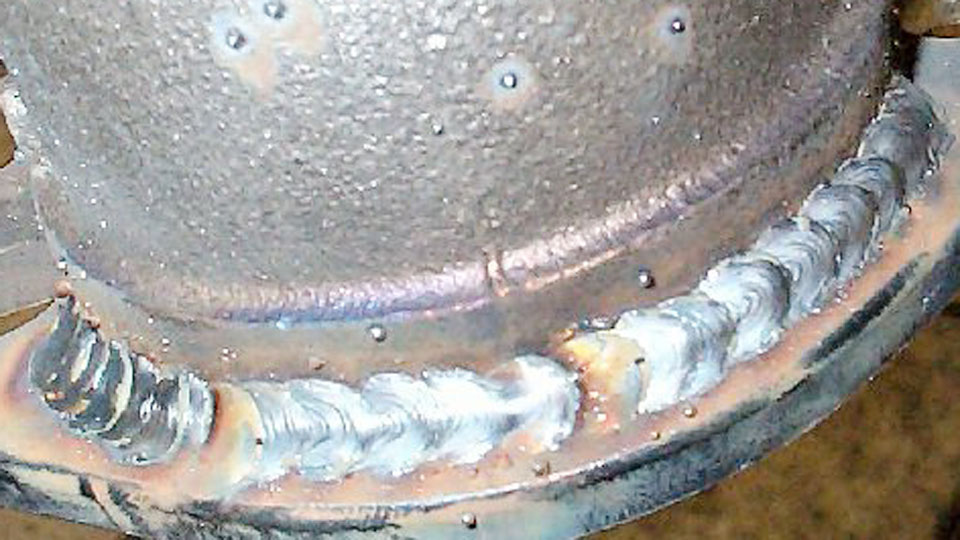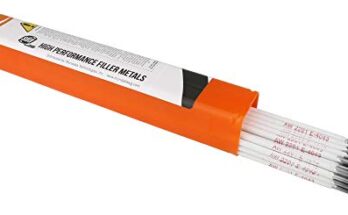Welding cast iron with flux core wire can be a real challenge, but it’s not impossible. If you’ve ever had to repair a cracked exhaust manifold, a broken engine block, or an old cast iron fixture, you know how tricky it can be.
Cast iron is brittle, prone to cracking, and doesn’t behave like mild steel when heated. Many people assume it can’t be welded properly, but with the right approach, you can get strong, reliable results using flux core welding.

Image by ls1tech
I’ve had my fair share of struggles with cast iron, and I know how frustrating it can be when cracks form as the metal cools. But after working with different techniques and materials, I’ve found what works and what doesn’t.
I’ll walk you through everything you need to know, from choosing the right wire to managing heat and cooling so your weld holds up over time.
Is It Possible to Weld Cast Iron with Flux Core?
Yes, it is possible to weld cast iron using a flux core wire, but it’s not the ideal method. Cast iron has high carbon content, which makes it prone to cracking and hardening when heated and cooled too quickly. While stick welding or TIG welding with nickel-based filler metal is often preferred, flux core welding can still work if you take the proper steps.
Here’s the thing: flux core welding runs hot, and excessive heat is the enemy of cast iron. That means you’ll need to control the heat input carefully and slow down the cooling process to prevent cracks.
Common Challenges When Welding Cast Iron
If you’re going to weld cast iron, it’s important to understand the main challenges so you can work around them.
- Brittleness – Cast iron is not ductile like mild steel, meaning it cracks under stress instead of bending.
- Porosity – The porous nature of cast iron can trap contaminants and weaken the weld.
- Heat Sensitivity – Too much heat can alter the carbon structure, making the material even more brittle.
- Cooling Issues – If it cools too fast, it will crack, especially near the weld zone.
Because of these challenges, you need to be very careful with heat control, preheating, and post-weld cooling.
Best Flux Core Wire for Welding Cast Iron
Choosing the right flux core wire is one of the most important steps when welding cast iron. Since flux core welding is typically designed for steel, finding a suitable wire for cast iron can be difficult.
Here are a few options that can work:
| Flux Core Wire | Composition | Best Used For |
|---|---|---|
| E71T-GS | General-purpose mild steel wire | Works for temporary or non-structural repairs |
| E70T-11 | All-position mild steel wire | Better for ductile cast iron, but still risky |
| Nickel-Based Wire | High nickel content | Best for strength and crack resistance, though rare in flux core |
Since there aren’t many dedicated flux core wires for cast iron, you may need to experiment with mild steel wires and use special welding techniques to improve success.
Prepping Cast Iron for Flux Core Welding
Good preparation is key to preventing cracking and getting a solid weld. Cast iron often has oil, grease, and impurities that can ruin your weld if they aren’t removed.
Here’s what you need to do:
- Clean the Metal Thoroughly – Use a wire brush, grinder, or chemical degreaser to remove any oil, grease, or paint from the surface.
- Preheat the Cast Iron – This is crucial. Heat the entire piece to around 500°F to 1200°F before welding. A propane torch or oven can help.
- Bevel the Edges – If you’re repairing a crack, grind a V-groove along the edges to improve penetration.
- Drill Stop Holes – If you’re welding over a crack, drill a small hole at each end of the crack to keep it from spreading.
Proper prep work will greatly improve your chances of getting a weld that holds up over time.
Best Welding Settings for Cast Iron with Flux Core
The right settings will depend on the thickness of the cast iron and the type of wire you’re using. However, here’s a general starting point:
| Setting | Recommended Value |
|---|---|
| Voltage | Low to medium (18-22V) |
| Wire Speed | Medium (Adjust based on travel speed) |
| Polarity | DCEN (Direct Current Electrode Negative) |
| Welding Position | Flat or horizontal preferred |
| Travel Speed | Slow and steady to control heat |
Keep in mind that cast iron doesn’t weld like mild steel, so you may need to adjust settings based on the specific job.
How to Weld Cast Iron with Flux Core Step by Step
Once your metal is clean and preheated, follow these steps carefully:
- Set Up Your Welder – Use the recommended settings and ensure your ground clamp is secure.
- Preheat the Metal – Gradually bring the entire piece up to temperature using a torch or oven.
- Start with Small Tack Welds – Apply small tacks to hold everything in place and avoid putting too much heat in one spot.
- Use a Stitch Welding Technique – Weld short 1-inch sections, then stop and let it cool slightly before continuing. This helps prevent heat buildup.
- Peen the Welds – Use a hammer to gently tap the weld while it’s cooling. This helps relieve stress.
- Slow Cool the Metal – Once the welding is done, wrap the part in a welding blanket, sand, or an insulating material to cool it down gradually.
Rushing the cooling process is the #1 cause of weld cracks in cast iron.
Post-Weld Treatment for Cast Iron
Once you’ve finished welding, don’t just leave it exposed to air. If it cools too fast, it will crack almost immediately. Here’s how to slow down the cooling process:
- Cover the Welded Part with a welding blanket, sand, or insulation.
- Keep it Warm for Several Hours before letting it return to room temperature.
- Inspect for Cracks once it’s fully cooled.
This slow cooling process reduces internal stresses and helps prevent post-weld fractures.
Conclusion
Welding cast iron with flux core is challenging, but with the right prep work and technique, it can be done. The biggest risks are cracking and brittleness, but by using preheating, proper wire, slow cooling, and careful welding techniques, you can make strong, durable repairs.
If you’re working on a critical or high-stress component, consider using a nickel-based wire or switching to stick welding with a proper cast iron rod. But for smaller repairs or non-load-bearing applications, flux core can work if you follow the right steps.
Frequently Asked Questions
Can I weld cast iron without preheating?
Preheating is strongly recommended because it reduces the risk of cracking. If you skip it, your weld will likely fail over time.
What’s the best flux core wire for cast iron?
There are no dedicated cast iron flux core wires, but mild steel wires like E71T-GS or E70T-11 can work for certain applications. Nickel-based wires are better but harder to find in flux core.
How do I prevent cast iron from cracking after welding?
Slow cooling is the key. Wrap the welded part in an insulating material like sand or a welding blanket to let it cool gradually.
Can I grind down my weld after welding cast iron?
Yes, but be careful. Grinding too aggressively can introduce stress and cause cracks. Use light grinding and avoid overheating the weld area.
Is flux core welding strong enough for cast iron?
It depends on the application. Flux core welding isn’t ideal for heavy-duty cast iron repairs, but it can work for low-stress, non-critical components.
